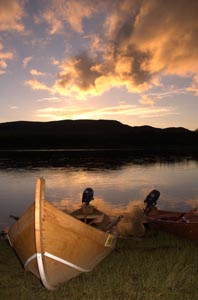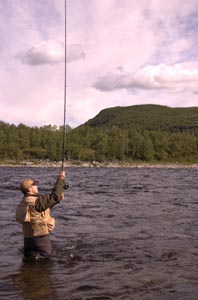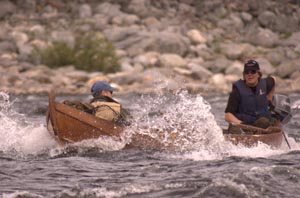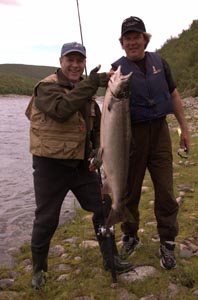SANTA CLAUS was on holiday and his reindeer were out to play. They gambolled along the roadside, all long thin legs, knobbly knees and splayed feet, shaking their huge furry antlers at irate drivers before veering unpredictably through the stationary cars and suddenly – gone. Into the forest.
Summer time in Lapland seems to bring out a devil-may-care attitude in the animal kingdom – and among the human population too.
When you spend a large proportion of the year gripped in an ice vice and several months in the darkness or eerie blue light of a sunless Arctic winter, it’s perhaps not surprising that the short high summer generates a spirit of glorious freedom and desire to gorge on the fruits of nature. The Finns take to the great outdoors en masse, camping, hiking, fishing, sailing, cycling.
An hour earlier we had landed at Ivalo, Finland’s most remote airport, 560 miles north of Helsinki and in all, about four hours flying from Edinburgh. Now we are driving along a wide, smooth and mostly deserted highway heading for the top of the world. Our destination, still another hour-and-a-half away, is the tiny township of Nuorgam, the most northerly point in the EU and just 20 miles from the Arctic sea.

Here at 70 deg North, a summer day lasts two months. It is nearly ten in the evening, 18 deg C., outside, and the sun beams low from a cloudless blue sky, bathing the endless birch and pine-clad hills in a rich green and orange glow. Regularly the trees open up with tantalising glimpses of sparkling lakes and rushing rivers. Here and there the lakes merge into a vast waterway that disappears into the distance.
This is the heartland of the Samek, the Lapps as they were formerly known; an enthralling race, rich in culture and tradition extending across northern Norway, Sweden, Finland and Russia.
Although their nomadic existence has disappeared, reindeer herding still dominates life. Houses in this wilderness are thinly scattered. The virgin forests are home to the deer, elk, bears, wolves, white grouse and, in the rivers and lakes, a cornucopia of fish. And it is salmon that has drawn us to this remote location. Two days to tame the Teno, the most prolific Atlantic salmon river in Europe, they claim.
Majestic the Teno is. Nearly 155 miles long, it forms the border between Norway and Finland for much of its journey as it flows north to Tanafjorden and the Arctic sea. In places it is maybe half-a-mile wide, peppered with islands and sweeping smoothly and steadily around large sandbanks. Elsewhere it funnels furiously through miles of granite boulder-strewn rapids to spew its millions of gallons of fresh water into the ocean.
The annual salmon catch is prodigious – around 75 tons were taken last year by rod and line anglers like ourselves and the numerous weir-netting stations – elegant traditional wood and stone structures which the locals set to trap the unwary.

While this seems a vast quantity by UK standards and was slightly up on the previous year, it is well down on 2001 when an astonishing 245 tons were recorded. But while the quantities are impressive, it is the size of the fish which draws anglers from around the world.
Salmon here truly deserve their title – king of fish; 50 to 60lb leviathans are occasionally landed each year on fly rods, 40lbs is frequent, and 20lbs plus are common. It is a prospect to set the heart of any angling enthusiast racing, mine included, especially since my personal record stands at a 9lb minnow taken from the Tweed a few years ago.
We press on. At Utsjoki we catch our first view of the river as it flows serenely under the elegant suspension bridge linking Finland to Norway. Here it is already nearly 100 yards wide, the water slow, dark, deep and mesmerising. Later, as the road twists and winds its way north-east following the riverbank it is difficult to concentrate on driving; glimpses of shimmering water and small boats peek through the trees. The river widens and the scale of the valley is at the same time both thrilling and genuinely awe-inspiring.
In spring, this wilderness undergoes an amazing metamorphosis as the land shakes off its winter cloak. Snow melt generates intense torrents of ice and rock as the Teno disgorges into the sea; there are no lakes along its length to absorb the flood waters.
Now it is July and the spate is over: the huge river seems almost placid when suddenly it disappears from our view and the rolling hills close in.
My colleague Neil checks our map; the Alaköngäs rapids – several miles of maelstrom as the river is concentrated into a narrow high-banked chasm. Here, the salmon, fresh from the sea will lie in eddys behind the huge rocks which sit just below the surface. Here we will fish tomorrow.

Then, just a suddenly, the river reappears and we are treated to yet another bewildering sight. As the Teno emerges from the rapids it fans out into shallower water. Dozens of anglers, shoulder to shoulder line the gravel beds which extend out into the centre of the river. Others are already up almost to their armpits, wading in the current. All are fly-fishing for that king of kings trophy.
It is 11.30 pm and the sun is still well above the horizon. These anglers will fish on through the endless daylight until their £14 permit expires at 7 a.m. and they enter a ballot for one of just 35 permits the next day. The banks are lined with tents, caravans, motor homes. Some have come for just a few days; others will stay for the entire month of the special quota system on this one tiny stretch of the river.
I feel initially a little disappointed; I had expected greater solitude. But this river is renowned and draws fly-fishers and game anglers from all over Europe, and as we discover, the wilderness devours even this number of people easily.
At Nuorgam we are greeted with a warm welcome by Raimo Hekkanen who with his wife own and manage the Lomakeskus Holiday Resort. The self-catering accommodation and campsite have been run by the family for 35 years. Our wooden chalet is clean, warm and dry. It smells comfortingly of pine, comes with its own private sauna and, helpfully, a large electric clothes drying cabinet. It seems such a commonsense appliance it is a wonder more are not available in Scotland, given our wet climate.
Next morning after a hearty breakfast supervised in the café by Raimo’s wife Marjatta, we meet our angling guide, Mauri, and drive to the river to tackle up.

Harling for salmon is popular throughout Scandinavia. Several rods are prepared either with fly or spinners and held in angled clamps at the stern of the boat. The rower then positions the boat bow-first into the current and allows it to drift downstream, guiding it at the same time over likely pools and lies.
The outboard springs to life and Mauri motors the elegant narrow boat for a couple of miles to the head of the Alaköngäs rapids and puts up four rods – two with fly and two with Rapalla-type lures. The flies are size 1 long-shank trebles tied in patterns familiar to any Scottish game angler. “Lady Ruth,” a raven-haired siren flecked with orange is favoured by the guide.
We drift towards the rapids in silence. Conversation is limited. Mauri has only broken English delivered with a strong accent and the Finnish and Sami languages have no Latin roots; they are related to Hungarian and I struggle to pick out any words – written or spoken – that I can understand.

Into the start of the rapids and there is a bang, a rod dips. A fish. Swiftly, Mauri reels in the other lines and I take the rod. The strain is heavy with the combined force of the current and the weight of the fish and after about 10 minutes my left arm is aching. This fish is huge. I can feel it shaking its head as it moves up and down the current.
The fear here always is that the line will snag behind a rock or simply fray as the fish bores and sulks behind the stones. And this monster is showing no signs of tiring. Suddenly, it turns and runs downstream. The Abu multiplier screams as line is stripped off. I can only try to brake the speed. Big fish, Mauri observes.
Eventually it halts and I reel in frantically as the boat catches up. I try to ease the fish up again. And suddenly, the line goes slack. The fish is off. Lady Ruth has failed to keep a hold on the Teno salmon, the fly has simply dislodged. I never even caught a glimpse of it.
How big, I ask? Mauri shrugs. Maybe 10-15 kilos. A quick mental conversion puts it in the 30lb class. I feel desolate. We restart the drift.
Almost immediately another fish is on. This time it has taken an orange and green lure and there is to be no escape. After another bicep-testing battle of 10 to 15 minutes, we beach my first Teno salmon. It tips the scales at 21.5lbs. Time for the cameras, handshakes all round and a celebratory bottle of Talisker for the boatman. Thumbs up and a big grin. Success speaks volumes in any language.
Later in the day my colleague Neil joins the fun with a grilse of just over 7lbs. Both fish are fit, fresh and unmarked.
Back at the campsite there’s a traditional reindeer stew served with creamed potato mash and crayberry sauce followed by a lesson in how to fillet a large fish in under a minute from Raimo who vacuum packs and freezes the catch for our journey home.
Nature now intervenes. Heavy rain starts and continues for the rest of the day and through the night. The next morning the huge river has risen by about 18 inches and the rapids are now foaming mad. Most of the fish will now have run on to higher reaches.
We drift and row and drift and row. We cast from the banks, we spin, but aside from a lone grayling our success is over. It’s as if the river has said: that was just a little taster, boys. Come back another time for the real fun.
And hopelessly hooked as we are, we most probably will.
(This article first appeared in The Herald Saturday magazine, in February 2007. This is a full version.)